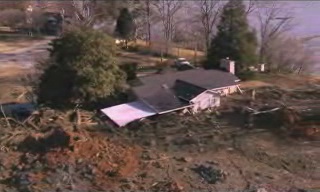Toxic coal ash dumping on the rise in the South

Three years after the disastrous coal ash spill from a collapsed impoundment at a Tennessee power plant, the volume of toxic waste that utilities are dumping into these failure-prone structures is on the rise -- and plants in the South stand out as especially heavy dumpers.
That's the finding of an analysis published last week by the Environmental Integrity Project, which looked at the most recent data from the U.S. Toxics Release Inventory. EIP found that disposal in impoundments or "ash ponds" was greater nationally in 2010 than in 2007 -- the year before the disaster at the Tennessee Valley Authority's Kingston plant in eastern Tennessee (photo above) sent a billion gallons of coal ash laden with heavy metals and radioactive elements into a residential community and nearby rivers.
"Not only are coal ash impoundment levels rising, rather than dropping, but we are seeing efforts by some in Congress to thwart EPA efforts to protect the health of Americans from toxic coal ash dump sites," said EIP Director Eric Schaeffer.
Besides causing spills like the one at Kingston, poorly overseen coal ash disposal also presents a hazard when its toxic ingredients seep into groundwater supplies. To date, the EPA and environmental advocates have documented over 130 cases nationwide where coal ash has caused environmental damages, most of them involving water contamination.
Following the December 2008 Kingston disaster, the Environmental Protection Agency under President Obama released two proposed regulations -- one strictly regulating coal ash as hazardous waste at the federal level, and the other treating it like non-hazardous waste and leaving its oversight largely up to the states.
The politically powerful electric utilities bristled at the idea of having their waste management subject to strict federal oversight and lobbied heavily to block that proposal. Some federal lawmakers took up their cause, introducing bills that would strip the EPA of the ability to impose strict federal regulations. In October, the Republican-controlled House passed such a bill, sponsored by Rep. David McKinley (R-W.Va.); a similar measure has been introduced in the Senate.
According to EIP's analysis, power plants reported dumping wastes containing 113.6 million pounds of toxic metals or metal compounds including arsenic, chromium and lead into on-site impoundments in 2010. That represents a 9 percent increase over 2009, and an increase over the total disposed in 2008.
EIP found that 20 plants account for more than half -- 57 million pounds -- of the toxic metals disposed of in surface impoundments at power plants in 2010. Of those 20 plants, 10 are in the South, as shown in this table from EIP's analysis:

Tags
Sue Sturgis
Sue is the former editorial director of Facing South and the Institute for Southern Studies.
